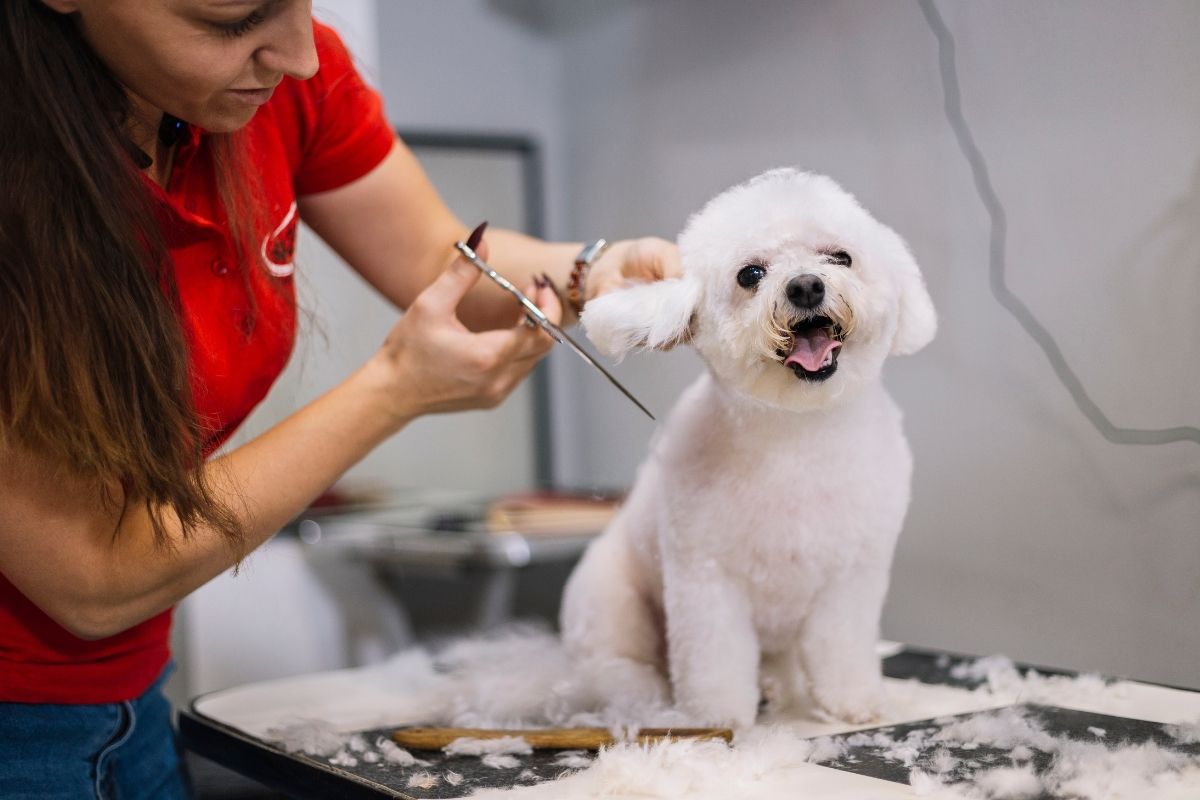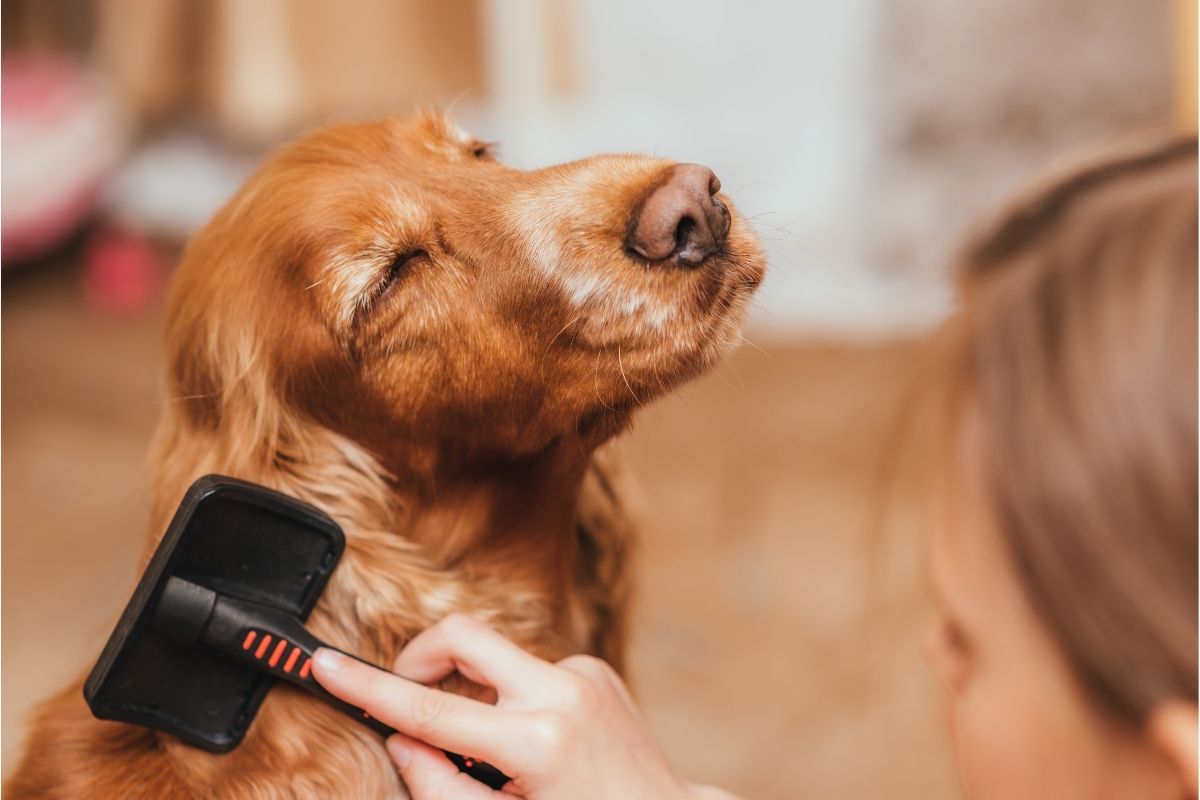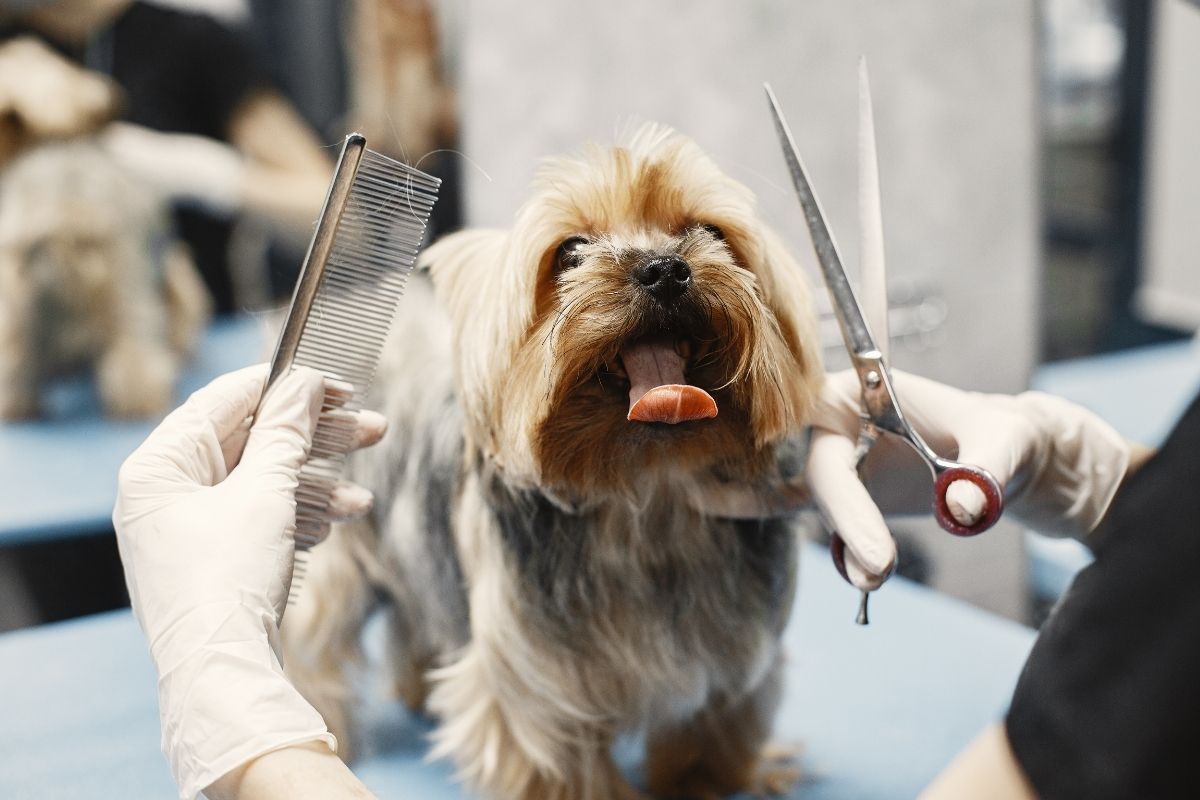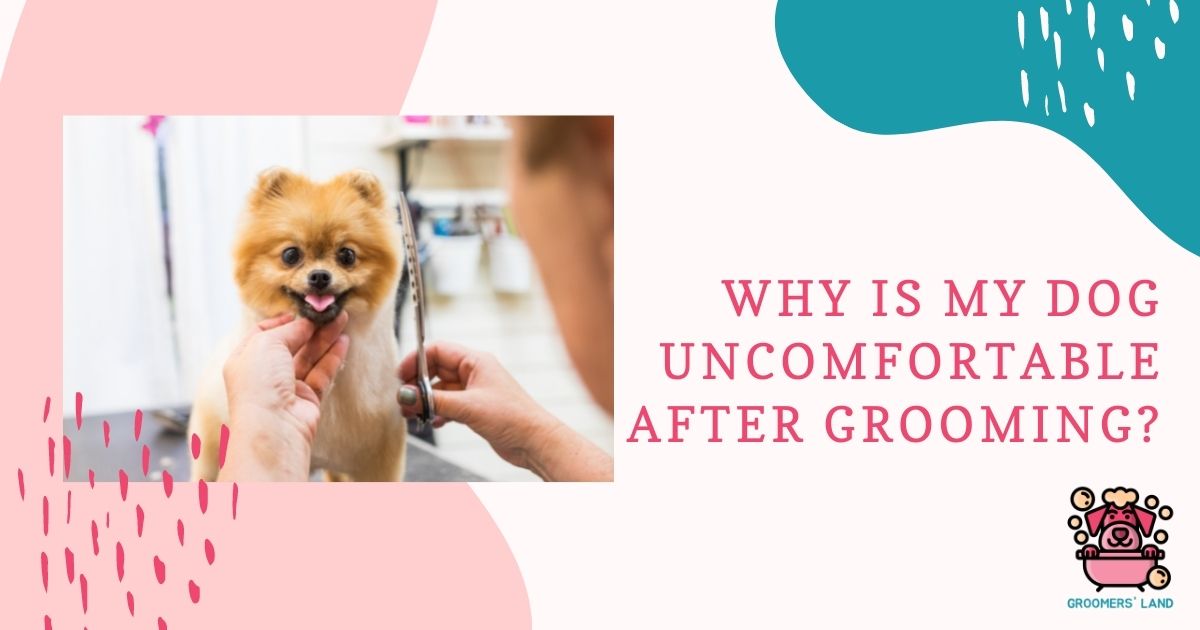Dogs and Grooming
Many pet owners wonder what makes a dog uncomfortable after grooming. They have complained over the years that their dog’s skin becomes itchy following a grooming appointment or a bath at home.
Good pet owners want to deal with inflamed skin after brushing and other activities so that their pet is not in pain. Let’s look at the possible causes and symptoms of this issue, as well as what you can do to address them.

Why Does My Dog Lick Her Private Area After Grooming?
If your pet licks their private regions incessantly after grooming, an overly tight shave might be the cause. It’s a delicate area; therefore, it doesn’t take much to irritate the skin. You might detect some vulva edema or redness in females.
If you notice your dog acting weird after grooming, act quickly. The dog’s attempts to relieve the discomfort may aggravate the region further.
An oatmeal anti-itching bath is one of the most remarkable home cures you can attempt. Pour a cupful of ground oatmeal into a warm bath for your dog. Allow your dog to soak in it for 10-15 minutes or longer if it has patience. If the dog relaxes after this, give it another calming wash.
Why is My Dog Uncomfortable After Grooming?
One of the most significant differences between getting your hair done and sending your dog to the groomer is that our groomers are responsible for more than just your dog’s hair. Your dog’s groomer does so much more than a simple wash and cut, with things like tear stains, ear cleaning, nail trimming, and anal gland expressions.
This high quality of service requires not only that your dog remains still but also that you, as a pet parent, give preventative care that will make their visit stress-free. Please continue reading to discover the top ten most frequent dog grooming injuries and how to avoid them;
Razor Burn on Dogs
Sometimes dogs have sensitive skin that isn’t visible or detectable merely by looking at them. For example, it can burn sensitive skin when a trip to the salon requires repetitive brushing in the same area, whether there are tangles or matting.
Dogs razor burn occurs when you shave an area very close to delicate skin, similar to brush burn. This could result from matting or cleaning up a dog’s feces. It can also appear when shaving through thick matted or pelted hair with a dull or hot razor.
Groomers and pet parents usually don’t discover these burns until their dog has licked, scratched, or broken open the skin due to the discomfort. Between appointments, brushing your dog with the right brush can help prevent the need for excessive brushing or shaving near to the skin. Make sure you’re brushing your dog correctly.
Hematomas
When a dog’s hair gets a matt, blood flow to that area is impeds. When you remove matted fur, blood rushes back to the site, resulting in a big blood blister known as a hematoma. These are prevalent in a dog’s ear and require treatment from a veterinarian. Brushing your dog properly in-between visits can help lessen the likelihood of matting and save your pet from agony.
Nicks and Scrapes
Nicks are minor cuts that appear when you use scissors or clippers. They can occur when a dog is highly jumpy or wiggly, if its skin is fragile, especially in elderly dogs, if the dog is pelted, or has concealed scabs, moles, or warts.
Starting your dog at the groomer’s as early as 12 weeks old will make them feel more at ease. In addition, requesting the same groomer each time can help build a bond between you and your dog, reducing the likelihood of your dog biting, thrashing, or jumping around on the grooming table.
The calmer your dog is for their appointment, the safer they will be and the better haircut they will receive. Practicing a grooming routine with your dog at home will also help them become comfortable with the process.
Ear Irritation
Ear plucking is the process of removing the hair from a dog’s ears to prevent matting and accumulation. When attempting to pluck hair that isn’t ready to come out, this technique might cause irritation and discomfort. It can also be irritating, making a dog fearful of the process if they aren’t used to it.
When it comes to ear plucking, pet caregivers should conduct their study. Professionals in the grooming and veterinary fields have differing perspectives on the benefits and drawbacks of this procedure, but the decision is ultimately yours.
Nails that Grow Quickly, Overgrown or Broken
It’s not easy to clip your dog’s nails. However, if you don’t groom your dog’s paws regularly, they’re more likely to overgrow or get damaged. Everyone’s nightmare is a set of quicken nails. Because each nail contains a blood vessel, cutting them too short might cause them to bleed.
While we have skilled groomers, this can happen if your dog’s blood vessels are naturally longer. When blood vessels in the nail have had more time to expand, they tend to be longer. Nail trimming regularly will assist these blood vessels in shrinking, making each nail cut shorter and more accessible for everyone.
Because the blood vessel grows longer, it is simpler to quicken a nail with overgrown nails. A dog’s nails, like human fingernails, never stop growing. As a result, your dog’s legs will curve outward – or worse, inward, making walking uncomfortable and difficult.
They may limp or be more sensitive now that they don’t have excessive nails and can walk normally on their tender paws.
Overgrown nails can either break off dangerously short or crack, exposing the blood vessel, resulting in broken or split nails. See a veterinarian for broken and split nails, unlike quickening the nail, which you may do at home or a salon. This is extremely painful for a dog and can lead to infection if left untreated.
Irritation of the Anal Glands
Anal glands are tiny sacs located inside your dog’s anus that naturally express when the bowel passes or your dog is scared. Allowing your dog to take care of this on their own is typically a good idea, but you may see your pup scooting, straining, smelling fishy, or licking the area and need to seek assistance.
When you go to the groomer, they will squeeze from the outside to express them. This will not empty the glands, but it will assist your dog get started. If you notice any leaking, bleeding, or swelling in your dog, you should contact your veterinarian to have them expressed internally.
Manually expressing anal glands frequently might weaken your dog’s muscles since their bodies become reliant on this manual technique rather than naturally expressing them. If you don’t keep up with it, this might lead to obstruction and even rupture.
Irritation of the Eyes
Your dog’s eyes are extremely sensitive. Natural eye discharge in particular puppies might create watery eyes, tear stains, or eye goop/crust. Even if you’re not disturbed by tear stains, it’s necessary to wipe your dog’s eyes daily if they’re prone to discharge.
You can soak away discharge in the tub by lathering up the region with warm water and rubbing or combing the discharge out with a little flea comb. However, due to trapped moisture at the root, if the discharge is too close to the skin or too widely scattered around the eye area, it can create irritation and even house infections.
If a dog’s eye discharge has caked on their skin for a long time, removing it can leave the region uncomfortable, itchy, and rough, driving them to rub their faces on anything that would bring relief. This can aggravate the situation more, necessitating a trip to the veterinarian.
Sanitary Matting
Fecal matting, penile matting, and vaginal matting can happen when you don’t brush hair thoroughly in these regions. Because sanitary matting can cause infection and irritation, keeping these areas clipped short and adequately cleaned is critical.
The dog’s sanitary area will be very sore once you remove the sanitary matting. This can cause them to lick and rub the region excessively, necessitating a trip to the veterinarian.
Yeast Infections
Yeast can thrive in any wet area of your dog’s body, but ears are a favorite. The yeast in your dog’s ear canal can be irritating, causing them to scratch excessively. To soothe the itch, a dog will scratch inside their ears with their feet, causing the yeast to spread to their feet. Unfortunately, yeast can spread to other parts of their body once they’re on their feet, causing a bigger problem.
Yeast can make dog grooming difficult because it produces dry, sticky skin that clippers can snag on, causing discomfort in the dog. In addition, scabs on dogs after grooming can form on skin that has scratching irritation, whether from yeast, dry skin, or fleas. Not to add that shampoo might irritate scabby and flared-up skin even more.
The best defense against yeast is to keep your dog’s ears, feet, and skin folds/wrinkles dry. Drying off places that easily trap moisture will help avoid infections, bacteria growth, and hot spots, whether you’re bathing at home, they just got out of the pool, or they’re coming in from the rain.
Brushing your dog regularly to prevent matting can also assist in lessening the quantity of moisture-trapped regions on your dog.

How Long Will My Dog Act Weird After Grooming?
If you own a poodle and take it for a grooming session, it shouldn’t surprise you if your dog behaves differently for the remainder of the day. This is because a poodle has a lot of hair. As a result, a poodle can feel a little too airy after a haircut. For the sole reason that your pup isn’t familiar with feeling airy, this sensation can be uncomfortable.
This is a sentiment that many people can relate to. For example, if you’ve always had long hair and decide to chop it short, you could feel uncomfortable and uneasy for a few days afterward. It’s not that you don’t like your new haircut; it’s just that you’re not used to the new length. So, if your dog appears to be avoiding you, you may not need to be concerned.
It’s still getting acclimated to its new coat. It believes it is powerless. Imagine having a haircut with no one asking if you want it. Sitting in the salon chair can be stressful.
Fortunately, one advantage of being human is that no one can force us to do anything we don’t want to do. Our puppies, on the other hand, cannot communicate. As a result, you won’t get their permission before taking them to the grooming salon.
How long will my dog act weird after grooming? It’s normal for your dog to be a little puzzled for the remainder of the day or even a few days following their grooming treatment because of this feeling of powerlessness.
Now that you know why your dog is acting weird after grooming appointments, it’s time to think about how you might make them feel less fearful and confused the next time they get their much-needed grooming.
How Will I Know if My Dog Has a Skin Irritation After Grooming?
Excessive scratching or licking of a specific place, as well as rubbing its face on the carpet, are some indicators of typical dog grooming injuries.
This is most likely due to the usage of a clipper blade that shaves too close. There are some rules in the grooming profession about what blade length to employ on different body regions to avoid clipper burn.
How to Help a Dog Feel Better After Grooming
Suppose your dog has recently had a groom, either professionally or at home, and is exhibiting any of these symptoms of irritated skin. There are immediate things you can take to make them feel better. For example, a room-temperature bath with oatmeal dog shampoo will help soothe inflamed nerves. In the short run, this should assist your pet.
Changes to the grooming routine are necessary for the long run. For example, if your dog gets skin irritation after a grooming session with electric clippers, ask what blade they’re using and have them go up a few numbers to a blade that leaves more hair on your dog and doesn’t cut it as short.
If it appears after a bath, especially if you’ve just started using a new shampoo or conditioner, switch to a different brand the next time. There are a variety of hypoallergenic and mild shampoos and conditioners on the market. Similarly, instead of using a human hairdryer, use a dog dryer to assist them in drying off after a wash.
Even on low, it might irritate your dog’s skin. You can do all of these things yourself or your groomer to avoid uncomfortable or inflamed skin in the future. Follow bathing and rinsing instructions carefully, and don’t over-bathe or over-cut your dog’s hair. These are sure ways to irritate their skin, especially in sensitive regions.
Can Grooming Cause Dogs Emotional Trauma?
Some dogs have no problem with grooming, but the process can be torturous for those who are more sensitive. You may notice the following signs and symptoms of emotional trauma:
- Pacing back and forth
- Aggressive actions
- Shaking or hiding
- In-house urination or defecation
The next time you take your dog to the groomer, they’ll remember the whole terrible episode and have a full-fledged panic attack.
To help them overcome their phobia, the most significant thing you can do is try counter-conditioning. Teach your dog that touching its head, ears, or privates is fine, and nothing terrible will happen to them. Also, please make an effort to socialize your dog more to become acclimated to being around strangers.
If your dog has had an awful grooming experience, try arranging for a different groomer. Of course, it would be ideal to find a professional who would come to your home.

Key Takeaways
Your dog may get hot spots after grooming or dislikes the groomer’s handling of its private parts. Use a soothing bath and some ointment to alleviate the itching.
Don’t make a big deal out of it; otherwise, you will reinforce your dog’s impression of themself as a victim of a heinous crime, and they’ll wreak havoc the next time you try to take them to the groomer.
Also, remember that a grooming session can be a distressing event for a dog, so take precautions to help them relax. This will prepare it for dog skin irritation after grooming. Alternatively, go to a different groomer the next time.

